The roots and coefficients of a quadratic equation can be connected by formulas that tell us about their relationship. Knowing these formulas can make it easier to work with quadratic equations and their graphs (parabolas).
So, what do you need to know about the roots & coefficients of a quadratic equation? For a quadratic equation ax2 + bx + c = 0, the sum of the roots is –b/a, and the product of the roots is c/a. If a & c have opposite signs, the quadratic equation will have two distinct real roots. If a > 0, the parabola is convex (concave up), and a < 0 means the parabola is concave (concave down).
Of course, the coefficients can give us other information as well. For example, the sign of c can also tell us whether the y-intercept of the parabola is above or below the x-axis.
In this article, we’ll talk about the relationship between the roots and coefficients of a quadratic equation. We’ll also give proofs and examples to make the concepts clear.
Let’s get started.
Roots & Coefficients Of A Quadratic Equation
The roots and coefficients of a quadratic equation are related in numerous ways. By looking at the signs of a, b, and c, we can sometimes tell when the roots will be real, imaginary, or complex.
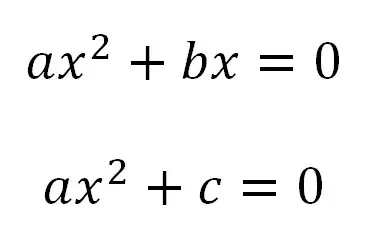
We can also express the sum and product of a quadratic equation’s roots in terms of the coefficients. Before we get into that, let’s look at two equivalent forms of a quadratic equation.
The first form is the standard form of a quadratic equation (a quadratic function that is set equal to zero). It is given by:
- ax2 + bx + c = 0
where a, b, and c are real numbers and a is nonzero. It has the following three terms:
- The quadratic term: ax2 (the first term in standard form)
- The linear term: bx (the second term in standard form)
- The constant term: c (the third term in standard form)
The second form is the factored form of a quadratic equation. It is given by:
- a(x – r)(x – s) = 0
where r and s are the roots of the quadratic equation (they may be real, imaginary, or complex). Note that the coefficient a is the same as in the standard form.
If we use FOIL for the factored form of a quadratic equation, we get:
- a(x2 – sx – rx + rs) = 0
- a(x2 – (r + s)x + rs) = 0
- ax2 – a(r + s)x + ars = 0
Setting this equal to the standard form gives us:
- ax2 + bx + c = ax2 – a(r + s)x + ars
Comparing like terms on each side reveals that:
- Quadratic Terms: a = a
- Linear Terms: b = -a(r + s)
- Constant Terms: c = ars.
This tells us a lot about how the roots (r, s) and coefficients (a, b, c) of the quadratic equation are related.
Relation Between Roots & Coefficients Of A Quadratic Equation
Given a quadratic equation in standard form and its roots, we can write two equations: one for the sum of the roots and one for the product of the roots.
We will give each one below, along with a proof using the quadratic formula.
Sum Of Roots Of Quadratic Equation
The sum of the roots of a quadratic equation is given by the formula
- r + s = -b / a
We can see this from the equation we wrote earlier when we compared linear terms on both sides of the equation ax2 – a(r + s)x + ars = 0:
- Linear Terms: b = -a(r + s)
- -b / a = (r + s)
So, to find the sum of the roots of a quadratic equation, take these steps:
- Take the linear coefficient, b.
- Divide by the quadratic coefficient, a. (This gives us b / a).
- Take the negative of the result. (This gives us –b / a).
Note that the sum of the roots will always exist, since a is nonzero (no zero denominator). This also means that the sum of the roots is zero whenever b = 0.
We can also use the quadratic formula to give a proof for the sum of quadratic roots formula.
Remember that for a quadratic equation ax2+ bx + c = 0 in standard form, the roots are given by the quadratic formula (pictured below).
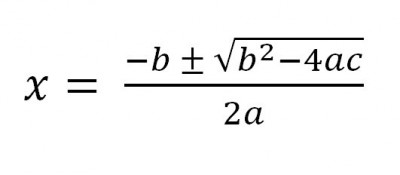
So, this means that the two roots r and s are given by:
- r = (-b + √(b2 – 4ac)) / 2a
- s = (-b – √(b2 – 4ac)) / 2a
To make things a little easier, let’s call the radical expression R:
- R = √(b2 – 4ac)
That means we can write the roots r and s like this:
- r = (-b + R) / 2a
- s = (-b – R) / 2a
If we add the roots, the radicals will cancel, since they have opposite signs:
- r + s
- =[(-b + R) / 2a] + [(-b – R) / 2a] [substitute formulas for roots r and s]
- =((-b + R) + (-b – R)] / 2a [add fractions, since 2a is a common denominator]
- =(-2b) / 2a [R and –R cancel, and we combine like terms to get -2b]
- =-b / a [divide by 2]
Example: Sum Of Roots Of A Quadratic Equation
For the quadratic equation 2x2 + 6x – 8 = 0, we have a = 2, b = 6, and c = -8.
This means that the sum of the roots is:
- –b / a = -6 / 2 = -3
Product Of Roots Of Quadratic Equation
The product of the roots of a quadratic equation is given by the formula
- rs = c / a
We can see this from the equation we wrote earlier when we compared constant terms on both sides of the equation ax2 – a(r + s)x + ars = 0:
- Constant Terms: c = ars.
- c / a = rs
So, to find the product of the roots of a quadratic equation, take these steps:
- Take the constant coefficient, c.
- Divide by the quadratic coefficient, a. (This gives us c / a).
Note that the product of the roots will always exist, since a is nonzero (no zero denominator). This also means that the product of the roots is zero whenever c = 0.
This is due to the fact that we will always get a zero root when c = 0:
- ax2 + bx + c = 0
- ax2 + bx + 0 = 0
- x(ax + b) = 0 [implies a root of x = 0]
We can also use the quadratic formula to give a proof for the product of quadratic roots formula.
Remember that for a quadratic equation ax2+ bx + c = 0 in standard form, the roots are given by the quadratic formula (pictured below).

So, this means that the two roots r and s are given by:
- r = (-b + √(b2 – 4ac)) / 2a
- s = (-b – √(b2 – 4ac)) / 2a
To make things a little easier, let’s call the radical expression R:
- R = √(b2 – 4ac)
That means we can write the roots r and s like this:
- r = (-b + R) / 2a
- s = (-b – R) / 2a
If we multiply the roots and FOIL, the middle terms will cancel, since they have opposite signs:
- rs = [(-b + R) / 2a][ (-b – R) / 2a] [substitute formulas for roots r and s]
- =(-b + R)(-b – R) / 4a2
- =(b2 + bR – bR – R2) / 4a2 [FOIL]
- =(b2 – R2) / 4a2 [cancel like terms]
- =(b2 – (b2 – 4ac)) / 4a2 [R = √(b2 – 4ac) means R2 = b2 – 4ac]
- =(4ac) / 4a2 [b2 terms cancel, due to opposite signs]
- =c / a [divide by 4a]
Example: Product Of Roots Of A Quadratic Equation
For the quadratic equation 2x2 + 6x – 8 = 0, we have a = 2, b = 6, and c = -8.
This means that the product of the roots is:
- c / a = -8 / 2 = -4
What If a Is Positive In A Quadratic Equation?
When the quadratic coefficient a is positive in a quadratic equation, it means several things:
- The graph of the quadratic is a parabola that opens upward (so it is convex, or concave up).
- The denominator of the quadratic formula is positive (the denominator is 2a, so if a > 0, then 2a > 0).
- If c is positive, the product of the roots of the quadratic is positive (c > 0 and a > 0 means c / a is positive).
- If c is negative, the product of the roots of the quadratic is negative (c < 0 and a > 0 means c / a is negative).
- If c is negative, then the discriminant is positive, and the quadratic equation has 2 distinct real roots (the discriminant is b2 – 4ac, so a positive and c negative means -4ac is positive, so b2 – 4ac is positive also).
You can see the image of a convex parabola (with a > 0) below.
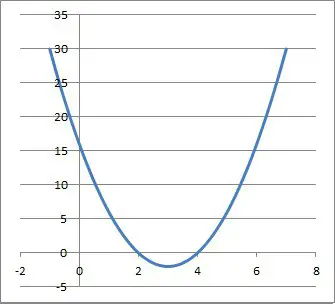
What If a Is Negative In A Quadratic Equation?
When the quadratic coefficient a is negative in a quadratic equation, it means several things:
- The graph of the quadratic is a parabola that opens downward (so it is concave, or concave down).
- The denominator of the quadratic formula is negative (the denominator is 2a, so if a < 0, then 2a < 0).
- If c is positive, the product of the roots of the quadratic is negative (c > 0 and a < 0 means c / a is negative).
- If c is negative, the product of the roots of the quadratic is positive (c < 0 and a < 0 means c / a is positive).
- If c is positive, then the discriminant is positive, and the quadratic equation has 2 distinct real roots (the discriminant is b2 – 4ac, so a negative and c positive means -4ac is positive, so b2 – 4ac is positive also).
You can see the image of a concave parabola (with a < 0) below.
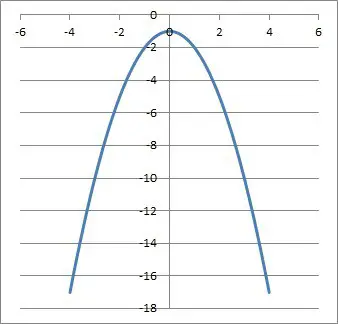
What If b Is Positive In A Quadratic Equation?
When the linear coefficient b is positive in a quadratic equation, it means two things:
- If a is positive, the sum of the roots of the quadratic is negative (a > 0 and b > 0 means -b / a is negative).
- If a is negative, the sum of the roots of the quadratic is positive (a > 0 and b < 0 means -b / a is positive).
What If b Is Negative In A Quadratic Equation?
When the linear coefficient b is negative in a quadratic equation, it means two things:
- If a is positive, the sum of the roots of the quadratic is positive (a > 0 and b < 0 means -b / a is positive).
- If a is negative, the sum of the roots of the quadratic is negative (a < 0 and b < 0 means -b / a is negative).
What If c Is Positive In A Quadratic Equation?
When the constant coefficient c is positive in a quadratic equation, it means several things:
- The y-intercept of the corresponding parabola is above the x-axis (it occurs at the point (0, c)).
- If a is positive, the product of the roots of the quadratic is positive (c > 0 and a > 0 means c / a is positive).
- If a is negative, the product of the roots of the quadratic is negative (c > 0 and a < 0 means c / a is negative).
- If a is negative, then the discriminant is positive, and the quadratic equation has 2 distinct real roots (the discriminant is b2 – 4ac, so a negative and c positive means -4ac is positive, so b2 – 4ac is positive also).
You can see the image of a parabola with a y-intercept above the x-axis (with c > 0) below.
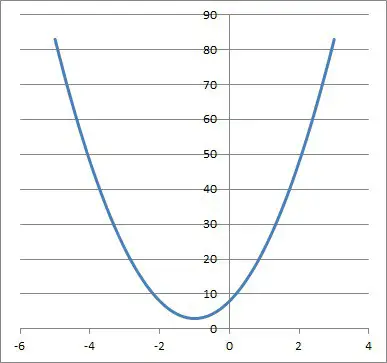
What If c Is Negative In A Quadratic Equation?
When the constant coefficient c is negative in a quadratic equation, it means several things:
- The y-intercept of the corresponding parabola is below the x-axis (it occurs at the point (0, c)).
- If a is positive, the product of the roots of the quadratic is negative (c < 0 and a > 0 means c / a is negative).
- If a is negative, the product of the roots of the quadratic is positive (c < 0 and a < 0 means c / a is positive).
- If a is positive, then the discriminant is positive, and the quadratic equation has 2 distinct real roots (the discriminant is b2 – 4ac, so a positive and c negative means -4ac is positive, so b2 – 4ac is positive also).
You can see the image of a parabola with a y-intercept below the x-axis (with c < 0) below.

Conclusion
Now you know all about the relationship between the roots and coefficients of a quadratic equation. You also know how to find the sum or product of the roots based on the coefficients of a quadratic equation.
You can also learn about quintic functions in my article here.
I hope you found this article helpful. If so, please share it with someone who can use the information.
Don’t forget to subscribe to my YouTube channel & get updates on new math videos!
~Jonathon

